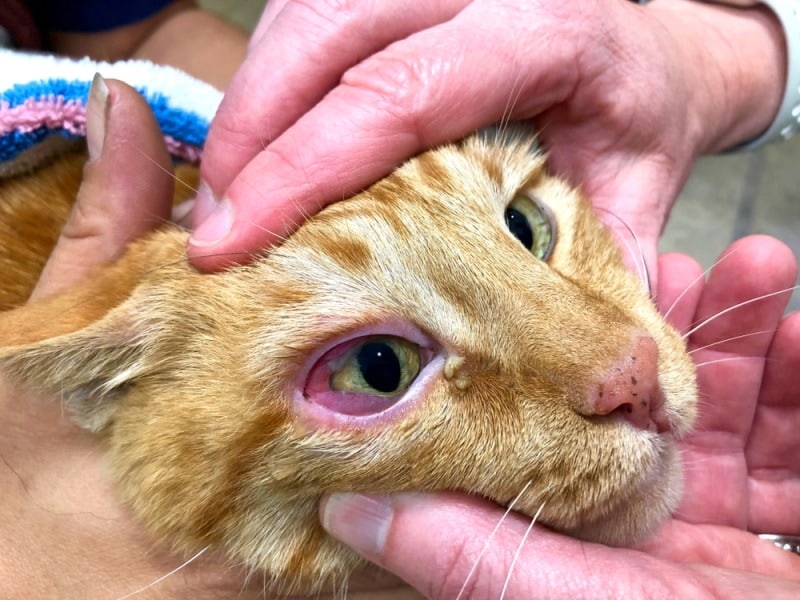Can a Cat Get Pink Eye? The answer is yes, cats can get pink eye, also known as conjunctivitis. It is a common eye infection that can affect one or both eyes. Pink eye in cats is usually caused by bacteria, viruses, or allergies.
Editor’s Notes: “Can a cat get pink eye” was last published on July 14, 2023. We have completely revised and updated the guide to reflect the latest information and research on this topic.
We understand that pink eye can be a serious concern for cat owners, so we’ve put together this guide to help you understand the causes, symptoms, and treatment options for pink eye in cats.
Key Differences
| Cause | Symptoms | Treatment |
|---|---|---|
| Bacteria | Redness, swelling, discharge | Antibiotic eye drops or ointment |
| Viruses | Redness, swelling, discharge, sneezing, coughing | Antiviral medication |
| Allergies | Redness, itching, watery discharge | Antihistamines or corticosteroids |
Main Article Topics
- Causes of Pink Eye in Cats
- Symptoms of Pink Eye in Cats
- Treatment Options for Pink Eye in Cats
- Prevention of Pink Eye in Cats
Can a Cat Get Pink Eye?
Pink eye, also known as conjunctivitis, is a common eye infection that can affect cats. It can be caused by bacteria, viruses, or allergies, and can be highly contagious. Understanding the key aspects of pink eye in cats is essential for cat owners to ensure proper care and treatment.
- Causes: Bacteria, viruses, allergies
- Symptoms: Redness, swelling, discharge, sneezing, coughing
- Treatment: Antibiotic eye drops or ointment, antiviral medication, antihistamines or corticosteroids
- Prevention: Keep cats up-to-date on vaccinations, avoid contact with infected cats, and practice good hygiene
- Diagnosis: Veterinary examination and diagnosis
- Contagiousness: Highly contagious, especially among cats
- Severity: Can range from mild to severe
- Recovery: With proper treatment, most cats recover quickly
These key aspects highlight the importance of understanding the causes, symptoms, treatment options, and prevention methods for pink eye in cats. By being aware of these aspects, cat owners can proactively protect their pets from this common infection and ensure their overall health and well-being.
Causes
Understanding the causes of pink eye in cats is crucial for effective prevention and treatment. Three primary causes of pink eye in cats are bacteria, viruses, and allergies.
- Bacteria: Bacterial infections are a common cause of pink eye in cats. Bacteria can enter the eye through a scratch or other injury, or they can be spread from another infected cat. Symptoms of bacterial pink eye include redness, swelling, and discharge from the eye.
- Viruses: Viral infections can also cause pink eye in cats. The feline herpesvirus (FHV-1) is a common cause of viral pink eye in cats. Symptoms of viral pink eye include redness, swelling, discharge, sneezing, and coughing.
- Allergies: Allergies can also cause pink eye in cats. Cats can be allergic to a variety of things, such as pollen, dust, and certain foods. Symptoms of allergic pink eye include redness, itching, and watery discharge from the eye.
It’s important to note that pink eye in cats can be highly contagious, especially among cats that are in close contact with each other. Therefore, it’s important to isolate any cat that is showing signs of pink eye to prevent the spread of infection.
Symptoms
The symptoms of pink eye in cats can vary depending on the underlying cause, but some of the most common symptoms include redness, swelling, discharge, sneezing, and coughing. These symptoms can be mild or severe, and they may affect one or both eyes.
- Redness: The whites of the eyes may become red and inflamed, and the blood vessels in the eye may become more visible.
- Swelling: The eyelids and conjunctiva (the clear membrane that covers the white of the eye) may become swollen and puffy.
- Discharge: The eye may produce a watery,, or mucoid discharge.
- Sneezing: If the pink eye is caused by a virus, the cat may also experience sneezing and coughing.
- Coughing: If the pink eye is caused by a virus, the cat may also experience coughing.
If your cat is showing any of these symptoms, it’s important to take them to the vet for diagnosis and treatment. Early diagnosis and treatment can help to prevent the infection from spreading and causing more serious problems.
Treatment
The choice of treatment for pink eye in cats depends on the underlying cause. Bacterial pink eye is typically treated with antibiotic eye drops or ointment. Viral pink eye is treated with antiviral medication. Allergic pink eye is treated with antihistamines or corticosteroids.
It is important to treat pink eye in cats promptly to prevent the infection from spreading and causing more serious problems. If left untreated, pink eye can lead to corneal ulcers, uveitis, and even blindness.
In some cases, surgery may be necessary to treat pink eye in cats. This is typically the case if the infection has caused a corneal ulcer or other serious complication.
The following table summarizes the different treatment options for pink eye in cats:
| Cause | Treatment |
|---|---|
| Bacteria | Antibiotic eye drops or ointment |
| Viruses | Antiviral medication |
| Allergies | Antihistamines or corticosteroids |
If your cat is showing signs of pink eye, it is important to take them to the vet for diagnosis and treatment. Early diagnosis and treatment can help to prevent the infection from spreading and causing more serious problems.
Prevention
Prevention is key when it comes to protecting your cat from pink eye. Here are a few things you can do to help prevent your cat from getting pink eye:
- Keep your cat up-to-date on vaccinations. Vaccinations can help to protect your cat from viral infections, such as feline herpesvirus (FHV-1), which can cause pink eye.
- Avoid contact with infected cats. If you know that a cat is infected with pink eye, it is best to avoid contact with that cat until the infection has cleared up.
- Practice good hygiene. Wash your hands thoroughly after handling a cat with pink eye, and avoid touching your own eyes.
By following these simple tips, you can help to prevent your cat from getting pink eye.
In addition to the above, there are a few other things you can do to help prevent the spread of pink eye in cats:
- Isolate infected cats. If your cat has pink eye, it is important to isolate them from other cats in your household to prevent the spread of infection.
- Clean and disinfect surfaces. Clean and disinfect any surfaces that your cat has come into contact with, such as bedding, toys, and food bowls.
- Dispose of used tissues and eye discharge. Dispose of used tissues and eye discharge from infected cats in a sealed bag to prevent the spread of infection.
By taking these steps, you can help to prevent the spread of pink eye in cats and protect your own cat from infection.
| Cause | Prevention |
|---|---|
| Bacteria | Keep your cat’s eyes clean and free of discharge. |
| Viruses | Get your cat vaccinated against FHV-1 and other common viruses. |
| Allergies | Identify and avoid allergens that trigger your cat’s allergies. |
Preventing pink eye in cats is important for their health and well-being. By following the tips above, you can help to keep your cat healthy and free from infection.
Diagnosis
Veterinary examination and diagnosis play a crucial role in determining whether a cat has pink eye. Pink eye, also known as conjunctivitis, is a common eye infection in cats that can be caused by bacteria, viruses, or allergies. A veterinarian will typically diagnose pink eye based on a physical examination of the cat’s eyes and a review of the cat’s medical history.
During the physical examination, the veterinarian will look for signs of redness, swelling, discharge, and other symptoms of pink eye. The veterinarian may also use a special dye to help visualize the cornea and conjunctiva, which can help to rule out other eye conditions.
In some cases, the veterinarian may also recommend additional tests, such as a tear test or a culture of the discharge from the eye. These tests can help to identify the underlying cause of the pink eye and guide treatment.
It is important to take your cat to the veterinarian if you suspect that they have pink eye. Early diagnosis and treatment can help to prevent the infection from spreading and causing more serious problems.
| Cause | Symptoms | Diagnosis | Treatment |
|---|---|---|---|
| Bacteria | Redness, swelling, discharge | Veterinary examination and diagnosis | Antibiotic eye drops or ointment |
| Viruses | Redness, swelling, discharge, sneezing, coughing | Veterinary examination and diagnosis | Antiviral medication |
| Allergies | Redness, itching, watery discharge | Veterinary examination and diagnosis | Antihistamines or corticosteroids |
By understanding the connection between “Diagnosis: Veterinary examination and diagnosis” and “can a cat get pink eye,” cat owners can ensure that their pets receive the proper care and treatment for this common eye infection.
Contagiousness
The contagious nature of pink eye in cats is a crucial aspect to consider, as it can significantly impact the health and well-being of both individual cats and cat populations. Understanding the modes of transmission, risk factors, and preventive measures associated with the contagiousness of pink eye is essential for cat owners and caregivers.
- Modes of Transmission: Pink eye in cats is highly contagious and can be spread through direct contact with an infected cat’s eyes, nose, or mouth. The virus or bacteria causing the infection can be transmitted through shared food bowls, bedding, or toys.
- Risk Factors: Kittens, senior cats, and cats with weakened immune systems are more susceptible to contracting pink eye. Overcrowded or unsanitary living conditions can also increase the risk of transmission.
- Preventive Measures: Vaccinating cats against feline herpesvirus (FHV-1), practicing good hygiene, and isolating infected cats can help prevent the spread of pink eye. Regular veterinary checkups are also important for early detection and treatment.
By understanding the contagious nature of pink eye in cats, cat owners can take proactive steps to protect their pets and prevent the spread of infection. This knowledge empowers individuals to make informed decisions regarding cat care and management, contributing to the overall health and well-being of cats.
Severity
The severity of pink eye in cats can range from mild to severe, depending on the underlying cause and the cat’s overall health. Mild cases of pink eye may only cause minor discomfort and redness, while severe cases can lead to corneal ulcers, uveitis, and even blindness.
- Mild Pink Eye: Mild cases of pink eye are typically caused by bacteria or allergies, and they may only affect one eye. Symptoms of mild pink eye include redness, swelling, and discharge.
- Moderate Pink Eye: Moderate cases of pink eye are typically caused by viruses, and they may affect both eyes. Symptoms of moderate pink eye include redness, swelling, discharge, sneezing, and coughing.
- Severe Pink Eye: Severe cases of pink eye can be caused by bacteria, viruses, or allergies, and they may lead to corneal ulcers, uveitis, and even blindness. Symptoms of severe pink eye include redness, swelling, discharge, pain, and vision problems.
It is important to take your cat to the vet if they are showing any signs of pink eye, regardless of the severity. Early diagnosis and treatment can help to prevent the infection from spreading and causing more serious problems.
Recovery
The prognosis for cats with pink eye is generally good. With proper treatment, most cats recover quickly and without any lasting problems. However, if the infection is severe or left untreated, it can lead to more serious complications, such as corneal ulcers, uveitis, and even blindness.
The key to a successful recovery is early diagnosis and treatment. If you think your cat may have pink eye, it is important to take them to the vet right away. The vet will be able to diagnose the underlying cause of the infection and prescribe the appropriate treatment.
Treatment for pink eye typically involves antibiotic eye drops or ointment, antiviral medication, or antihistamines. The vet may also recommend cleaning the cat’s eyes with a warm compress. In severe cases, surgery may be necessary to treat corneal ulcers or other complications.
With proper treatment, most cats recover from pink eye quickly and without any lasting problems. However, it is important to follow the vet’s instructions carefully and to complete the full course of treatment. This will help to prevent the infection from recurring and causing more serious problems.
Table: Recovery from Pink Eye in Cats
| Cause | Treatment | Recovery Time |
|---|---|---|
| Bacteria | Antibiotic eye drops or ointment | 7-10 days |
| Viruses | Antiviral medication | 10-14 days |
| Allergies | Antihistamines | Varies depending on the allergen |
FAQs on Pink Eye in Cats
Pink eye, also known as conjunctivitis, is a common eye infection in cats that can be caused by bacteria, viruses, or allergies. It is important to understand the causes, symptoms, and treatment options for pink eye in cats to ensure their health and well-being.
Question 1: Can cats get pink eye?
Answer: Yes, cats can get pink eye. It is a common eye infection that can affect one or both eyes.
Question 2: What are the symptoms of pink eye in cats?
Answer: Symptoms of pink eye in cats include redness, swelling, discharge, sneezing, and coughing.
Question 3: What causes pink eye in cats?
Answer: Pink eye in cats can be caused by bacteria, viruses, or allergies.
Question 4: How is pink eye in cats treated?
Answer: Treatment for pink eye in cats depends on the underlying cause. Bacterial pink eye is treated with antibiotic eye drops or ointment. Viral pink eye is treated with antiviral medication. Allergic pink eye is treated with antihistamines or corticosteroids.
Question 5: Is pink eye in cats contagious?
Answer: Yes, pink eye in cats is highly contagious, especially among cats that are in close contact with each other.
Question 6: How can I prevent my cat from getting pink eye?
Answer: You can prevent your cat from getting pink eye by keeping them up-to-date on vaccinations, avoiding contact with infected cats, and practicing good hygiene.
Summary: Pink eye is a common eye infection in cats that can be caused by bacteria, viruses, or allergies. It is important to understand the symptoms, causes, and treatment options for pink eye in cats to ensure their health and well-being.
Transition to the next article section: For more information on pink eye in cats, please consult with your veterinarian or a qualified animal health professional.
Tips for Preventing and Treating Pink Eye in Cats
Pink eye, also known as conjunctivitis, is a common eye infection in cats that can be caused by bacteria, viruses, or allergies. It is important to understand how to prevent and treat pink eye in cats to ensure their health and well-being.
Tip 1: Keep your cat’s eyes clean and free of discharge. This will help to prevent bacteria and other microorganisms from entering the eyes and causing infection.
Tip 2: Avoid contact with infected cats. If you know that a cat is infected with pink eye, it is best to avoid contact with that cat until the infection has cleared up.
Tip 3: Vaccinate your cat against feline herpesvirus (FHV-1). FHV-1 is a common cause of viral pink eye in cats. Vaccinating your cat against FHV-1 can help to prevent them from getting this infection.
Tip 4: Treat pink eye promptly. If you think your cat has pink eye, it is important to take them to the vet right away. Early diagnosis and treatment can help to prevent the infection from spreading and causing more serious problems.
Tip 5: Follow the vet’s instructions carefully. If your cat is diagnosed with pink eye, it is important to follow the vet’s instructions carefully. This will help to ensure that your cat gets the best possible care and recovers quickly.
Summary: Pink eye is a common eye infection in cats that can be caused by bacteria, viruses, or allergies. By following these tips, you can help to prevent and treat pink eye in your cat and ensure their health and well-being.
Transition to the article’s conclusion: For more information on pink eye in cats, please consult with your veterinarian or a qualified animal health professional.
Conclusion
Pink eye, also known as conjunctivitis, is a common eye infection in cats that can be caused by bacteria, viruses, or allergies. It is important to understand the causes, symptoms, and treatment options for pink eye in cats to ensure their health and well-being.
Early diagnosis and treatment are essential for preventing serious complications from pink eye. If you think your cat has pink eye, it is important to take them to the vet right away. The vet will be able to diagnose the underlying cause of the infection and prescribe the appropriate treatment.
By understanding pink eye in cats and taking steps to prevent and treat it, you can help to ensure the health and well-being of your feline companion.
Youtube Video:



